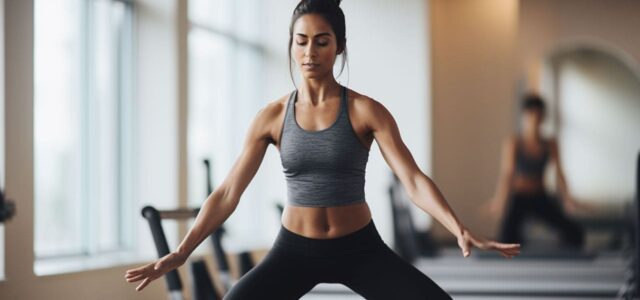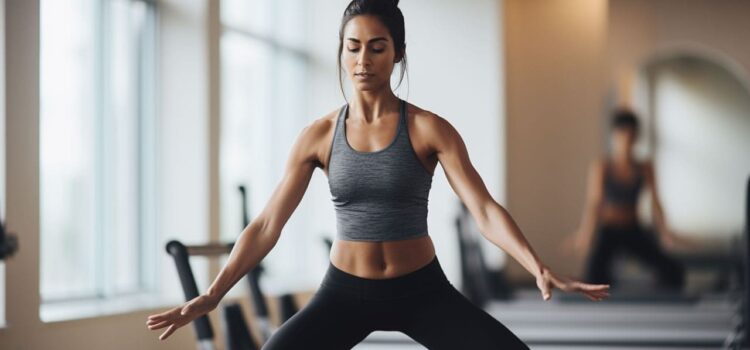

7 Reasons to Use Pilates for Half Marathon Training
Cross-Training for Half Marathons August 4, 2023 admin 0

Hello, my dedicated runners! It’s your ever-encouraging coach back with another piece of running wisdom to share. Let’s stretch our understanding beyond the track, trail, or treadmill today. Yes, we’re stepping into the peaceful, precise world of Pilates.
So, you’ve been logging the miles, and you’re feeling confident about the cardio aspect of your half marathon training. But, have you given a thought about strengthening your body and improving your flexibility? That’s where Pilates for half marathon training enters the scene.
What is Pilates?
Pilates, developed by Joseph Pilates in the early 20th century, is a low-impact exercise method that focuses on core strength, flexibility, and overall body awareness. It might seem far removed from the running track, but this method offers a myriad of benefits to runners. Let’s dive into why Pilates is your secret weapon for half marathon training.
Reason 1: Core Strength
A strong core is the powerhouse of a runner’s body. It’s not just about those magazine-cover worthy abs, but the entire belt of muscles that wraps around your midsection, including your lower back and obliques. When these muscles are strong, they support your spine, maintain your running posture, and help to transfer power between your upper and lower body. This can make your running more efficient and decrease the strain on your joints. Incorporating Pilates into your training routine can help strengthen these crucial muscles, keeping you running strong mile after mile.
Reason 2: Balance and Stability
Running, when you break it down, is essentially a series of one-legged hops in quick succession. This means balance and stability are key components of efficient, injury-free running. Pilates exercises often involve isolating and engaging specific muscles while maintaining balance. For example, a Pilates move may require you to hold a plank while moving one leg—sounds a bit like running, right? Regular practice can significantly enhance your stability, making each of those one-legged hops more controlled and powerful.
Reason 3: Improved Flexibility
Runners, we’re not exactly known for our flexibility, are we? Many of us can log double-digit miles but struggle to touch our toes. Here’s where Pilates shines. The method involves slow, controlled movements that lengthen the muscles without straining them. Over time, this can improve your overall flexibility, leading to a more fluid running stride and decreased risk of injuries like strains and pulls. Plus, flexible muscles are more resilient, better able to absorb the impact of each footfall.
Reason 4: Injury Prevention
When we run, we engage certain muscle groups more than others. This can lead to muscle imbalances, which can further lead to injuries. Pilates is all about balanced body conditioning, strengthening the smaller, often-neglected muscles to support the larger ones. This full-body conditioning approach can help correct muscle imbalances, reducing the risk of overuse injuries. Regular Pilates training can be your secret weapon for staying injury-free on the road to your half marathon.
Reason 5: Better Breathing
If you’ve ever gasped your way to the end of a long run or struggled up a hill, you know how crucial efficient breathing is. Pilates places a significant emphasis on breath control, teaching techniques to enhance diaphragmatic breathing. Over time, this can increase your lung capacity and improve the efficiency of your oxygen supply when running. Plus, the focus on breath can also help you maintain rhythm and pace during your runs, making those long miles just a little bit easier.
Reason 6: Recovery and Relaxation
After a long run, Pilates can be an excellent tool for active recovery. It encourages slow, controlled movements and deep breathing, both of which can help relax the muscles and speed up recovery. Plus, Pilates helps improve circulation, flushing out the toxins and bringing fresh nutrients to your muscles. All these factors combined can reduce post-run soreness and get you ready for your next training session.
Reason 7: Body Awareness
Finally, Pilates encourages mindful movement. Each exercise requires focus and awareness, cultivating a strong mind-body connection. This increased body awareness can be extremely beneficial for runners. It can help you identify when your form is faltering or when a certain muscle group is overworking. This early detection system allows you to adjust your running form or training plan before minor issues become significant problems. Ultimately, it helps you become a more intuitive runner, tuned into your body’s needs and responses.
Wrapping Up
Incorporating Pilates into your half marathon training plan could be the game-changer you need. It offers strength, flexibility, and an enhanced awareness of your body. Remember, the journey to the finish line isn’t just about pounding the pavement—it’s about creating a balanced body through cross-training that can sustain the demands of a 13.1-mile race.
No comments so far.
Be first to leave comment below.